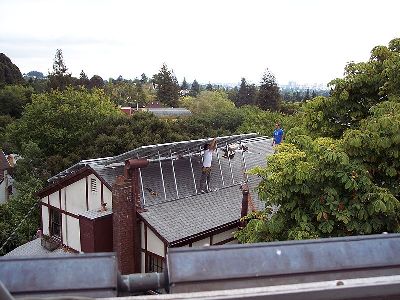Environment
Using Your Roof as a Source of Energy and Water
by Chase Roberts
One of the cheapest and simplest sources of energy and water sits suspended over millions of peoples’ heads: the rooftop. This underused commonality of architecture can and should be utilized to decrease the cost burden that has become so typical with household utilities. Localized renewable energy and water sources are becoming an economic necessity whose time has fully come.
rooftop. This underused commonality of architecture can and should be utilized to decrease the cost burden that has become so typical with household utilities. Localized renewable energy and water sources are becoming an economic necessity whose time has fully come.
Rooftop Solar Installations
Rooftop photovoltaic solar panel installations can supplement or replace a home’s non-renewable energy usage and often eases the hardship of increased winter utility rates. When combined with energy storage technology, the sun’s power would be useable even on the cloudiest days.
Current storage technologies for energy produced through photovoltaic panels consist of either rerouting the unused portion of energy back to the grid’s commencement, or using on-site battery back-up type systems that operate during power outages and natural disasters affecting the local grid, much like gas-powered generators. On-site battery storage can lower consumer cost during peak hours of electricity usage. The consumer would have to keep in mind that the system would need to be recharged when necessary, which may draw from the household’s usual solar power usage.
Inexpensive Solar Options
Getting a better idea of the possibilities of solar power is easy. Most consumers will happily embrace rooftop solar technologies, but for those who are still on the fence about it, starting with a smaller installation is a great idea. Solar hot water heaters and solar attic fans are smaller installations that are great introductions to rooftop solar technology and the possible cost savings entailed with larger installations.
Rooftop Water Collection
Rooftop water collection devices are really nothing new. Water channeling gutters have been used in villages throughout Europe for centuries. These lead to barrels for watering animals and garden plants. Ecologically minded people have again popularized this method, for the most part, but it has always been used by home gardeners who are fueled by common sense. There are currently no federal regulations or laws regarding rainwater collection but many townships and cities across the United States have voted laws into effect in favor of rainwater collection.
Typically, for every inch of rainfall, rainwater harvesting installations can collect about .62 gallons of rainwater per square foot of rooftop area. For example, in an area with an average annual rainfall of 32 inches, when collected into barrels or tanks, water savings can equal up to 34,000 gallons of repurpose-able water each year, even after allowing for possible evaporation, gutter overflow, and leaks in the system. Rainwater collection is not only a smart option in areas that get plenty of rain each year, it is an excellent option for areas subject to drought.
Uses for Collected Water
Rain barrels can be retrofitted with a spigot that feeds the water through hoses wound through a garden plot. This offers a gentle, constant water source for plants. Water can also be diverted to an elevated barrel that has been retrofitted with a filtered hose or shower head for an outdoor shower, making it a great option for pool areas.
Rooftop solar energy and rainwater collection are unobtrusive ways to claim energy independence.
About the Author
Chase Roberts is an earth-friendly home and garden expert. If you’re looking for ways to trim down your energy bill, Chase suggests considering a new roof from Remedy Roofing. A new roof can patch up any air leaks that might be allowing your A/C and heat to be wasted.




